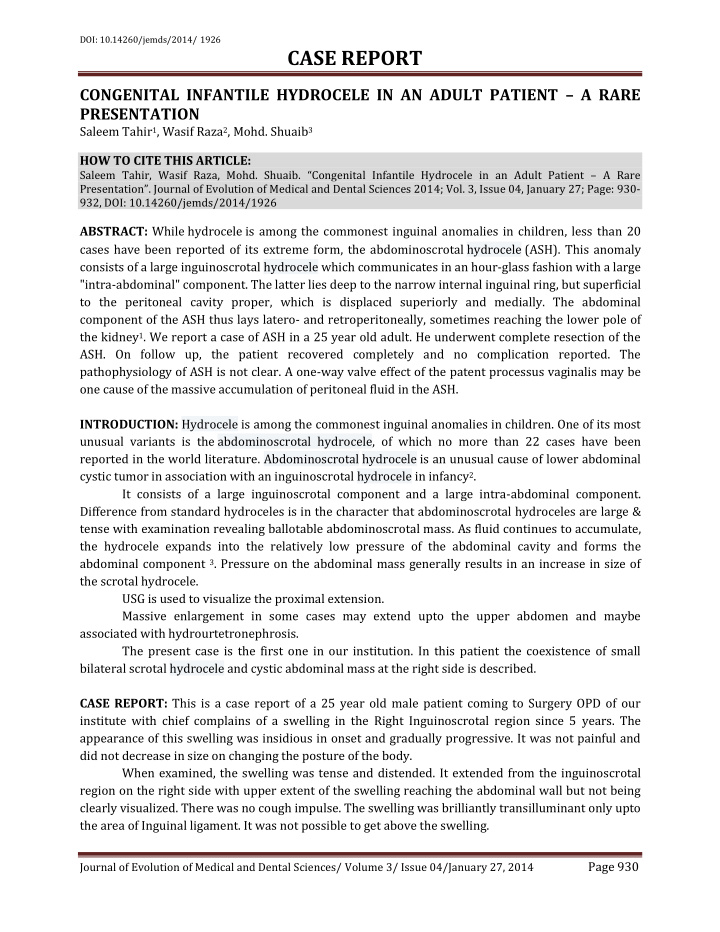



DOI: 10.14260/jemds/2014/ 1926 CASE REPORT CONGENITAL INFANTILE HYDROCELE IN AN ADULT PATIENT – A RARE PRESENTATION Saleem Tahir 1 , Wasif Raza 2 , Mohd. Shuaib 3 HOW TO CITE THIS ARTICLE: Saleem Tahir, Wasif Raza, Mohd. Shuaib. “ Congenital Infantile Hydrocele in an Adult Patient – A Rare Presentation ”. Journal of Evolution of Medical and Dental Sciences 2014; Vol. 3, Issue 04, January 27; Page: 930- 932, DOI: 10.14260/jemds/2014/1926 ABSTRACT: While hydrocele is among the commonest inguinal anomalies in children, less than 20 cases have been reported of its extreme form, the abdominoscrotal hydrocele (ASH). This anomaly consists of a large inguinoscrotal hydrocele which communicates in an hour-glass fashion with a large "intra-abdominal" component. The latter lies deep to the narrow internal inguinal ring, but superficial to the peritoneal cavity proper, which is displaced superiorly and medially. The abdominal component of the ASH thus lays latero- and retroperitoneally, sometimes reaching the lower pole of the kidney 1 . We report a case of ASH in a 25 year old adult. He underwent complete resection of the ASH. On follow up, the patient recovered completely and no complication reported. The pathophysiology of ASH is not clear. A one-way valve effect of the patent processus vaginalis may be one cause of the massive accumulation of peritoneal fluid in the ASH. INTRODUCTION: Hydrocele is among the commonest inguinal anomalies in children. One of its most unusual variants is the abdominoscrotal hydrocele, of which no more than 22 cases have been reported in the world literature. Abdominoscrotal hydrocele is an unusual cause of lower abdominal cystic tumor in association with an inguinoscrotal hydrocele in infancy 2 . It consists of a large inguinoscrotal component and a large intra-abdominal component. Difference from standard hydroceles is in the character that abdominoscrotal hydroceles are large & tense with examination revealing ballotable abdominoscrotal mass. As fluid continues to accumulate, the hydrocele expands into the relatively low pressure of the abdominal cavity and forms the abdominal component 3 . Pressure on the abdominal mass generally results in an increase in size of the scrotal hydrocele. USG is used to visualize the proximal extension. Massive enlargement in some cases may extend upto the upper abdomen and maybe associated with hydrourtetronephrosis. The present case is the first one in our institution. In this patient the coexistence of small bilateral scrotal hydrocele and cystic abdominal mass at the right side is described. CASE REPORT: This is a case report of a 25 year old male patient coming to Surgery OPD of our institute with chief complains of a swelling in the Right Inguinoscrotal region since 5 years. The appearance of this swelling was insidious in onset and gradually progressive. It was not painful and did not decrease in size on changing the posture of the body. When examined, the swelling was tense and distended. It extended from the inguinoscrotal region on the right side with upper extent of the swelling reaching the abdominal wall but not being clearly visualized. There was no cough impulse. The swelling was brilliantly transilluminant only upto the area of Inguinal ligament. It was not possible to get above the swelling. Journal of Evolution of Medical and Dental Sciences/ Volume 3/ Issue 04/January 27, 2014 Page 930
DOI: 10.14260/jemds/2014/ 1926 CASE REPORT A sonography of the scrotum & abdomen revealed an Abdominoscrotal hydrocele extending upto the umbilicus with rest abdominal findings within normal limits. Patient was planned for surgical exploration with excision of sac under spinal anesthesia. Through an inguinal incision, the sac was approached. It was burst open and the fluid drained. The remaining sac was excised and the testis was replaced into the scrotum. A drain was put which was removed on the third day. Daily dressing and cleaning of the wound was done. The sutures were removed on the 8 th day and patient was discharged. On follow up the patient was relieved of his complains and there were no complications. DISCUSSION: Abdominoscrotal hydroceles are suspected on clinical examination and confirmed on a Sonography. They are primarily treated by surgical approach through inguinal incision with excision of the sac with / without orchidopexy. Laparoscopic approaches have also been used to treat the same. In our case, proper diagnosis and management with good general health of patient averted any eventuality. Despite low prevalence, clinical profile is helpful in diagnosing the patient further. An early intervention is suggested both for prevention and management of complications. Failure to recognize the abdominal component is a cause of recurrence. The prognosis of testicular function in abdominoscrotal hydrocele and the risk of possible long term post-operative complications remain unknown. REFERENCES: 1. Luks FI et al. The Abdominoscrotal Hydrocele. European Journal of Pediatric Surgery. 1993 Jun; 3(3):176-8. 2. Liolios N et al. Abdominoscrotal Hydrocele. European Journal of Pediatric Surgery. 1997 Dec; 7(6):371-2. 3. Gentile et al. Abdominoscrotal Hydrocele in Infancy. Urology, Volume 51, Issue 5, Supplement 1, May 1998:20-22. Journal of Evolution of Medical and Dental Sciences/ Volume 3/ Issue 04/January 27, 2014 Page 931
DOI: 10.14260/jemds/2014/ 1926 CASE REPORT Pre-op AUTHORS: 1. Saleem Tahir NAME ADDRESS EMAIL ID OF THE 2. Wasif Raza CORRESPONDING AUTHOR: 3. Mohd. Shuaib Dr. Wasif Raza, Dept. of Surgery, PARTICULARS OF CONTRIBUTORS: Era’s Lucknow Medical College, 1. Assistant Professor, Department of General Lucknow. Surgery, Era’s Lucknow Medical College, E-mail: dr.razawasif@gmail.com Lucknow. 2. Senior Resident, Department of General Date of Submission: 09/01/2014. Surgery, Era’s Lucknow Medical College, Date of Peer Review: 10/01/2014. Lucknow. Date of Acceptance: 17/01/2014. 3. Junior Resident, Department of General Date of Publishing: 23/01/2014. Surgery, Era’s Lucknow Medical College, Lucknow. Journal of Evolution of Medical and Dental Sciences/ Volume 3/ Issue 04/January 27, 2014 Page 932
Recommend
More recommend